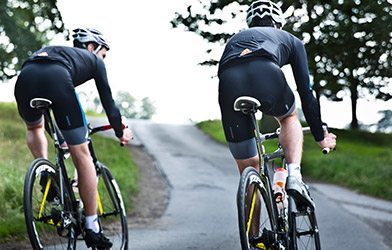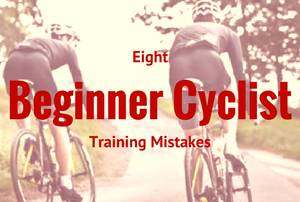We were all beginner cyclists at one time. There's nothing like the thrill of trying something new and seeing ourselves improve quickly. Beginners typically improve the fastest out of anyone when they start training, but they often make major training mistakes and not even know it. These training mistakes tend to limit the fitness gains beginners see and cause them to get discouraged or frustrated and even cause them to stop riding. That's a huge issue for anyone who's new to cycling.
I'll tell you something else, too. Beginners aren't the only ones who make these mistakes. Even long-time veterans to the sport can get caught out making these training mistakes that will hurt their fitness and skill progression.
In this podcast, I'll cover these big training mistakes and give you tips on how to correct them. So click through and find out if you're making these training mistakes:
Podcast: Play in new window | Download (Duration: 1:05:31 — 90.0MB)
Subscribe: RSS
 Podcast Show Notes
Podcast Show Notes
@ 6:25 – What is a beginner?
- 3 years or less of experience training on a bike (beginners may have ridden casually for years, but for all intents and purposes beginners start at their first season of cycling as their primary sport.)
- typically hasn't realized their fitness potential yet
- sees significant improvement from season start to end (the 25% improvement in speed, 12mph-16mph, going from 20 miles to 60 miles, etc)
- Typically focuses more on increasing mileage than increasing skills and fundamentals (start focusing on these later when they stop improving from just riding.)
- can improve without specific training plans designed for them. (but improves faster when using structured programs, and won't form bad habits when using a training plan.)
- WILL hit a point where they stop improving with the “same old same old” riding.
These following mistakes are obviously things beginners make, but a LOT of more experienced riders make the same mistakes as well.
@ 14:48 – Training mistakes made during the season
Going out too hard (Strava is one of the big culprits here: we feel like we're forced to go out hard to impress everyone who watches us.)
- This is generally a case of starting too hard because the group is really fast, you're over-excited or your EGO gets the better of you.
- If you go out really hard, you're burning up anaerobic fuel before warming up (leg speed/neuromuscular connections aren't working well, aerobic system is not operating efficiently yet, etc)
- Generally results in ending up empty by the midpoint of a ride (you can see this with riders needing to refuel often later in a ride as they are always operating at an energy deficit)
- Fix it: sufficient warmup, high leg speed techniques at minimal pedal tension, slowly add tension as the warmup progresses, proper pre-ride fueling, building more aerobic fitness so you can hang with the group. The first part of a ride should be at your Sweet Spot Zone, and shouldn't feel “hard.”
- Note: All these points apply to shorter segments of a ride as well, such as a hill climb.
Being afraid of riding with those who are better/faster than you
- Riding with those better forces you to ride to their level
- You are forced to work hard to stay in the slipstream and stay on the wheel, and it's easier since drafting saves 30% energy.
- Even if you're saving up to 30%, you're still probably working harder than you would be if you were riding alone.
- Staying with the group is a huge motivator and mental boost, and if you get dropped you'll work harder to hang on just a little longer next time. You can see big improvement in that respect.
- Fix it: Get in more Sweet Spot Training work to build aerobic conditioning so you can ride in the slipstream and hang with the faster guys.
Being afraid of riding off road
- Don't be! The pros ride basically the same bikes and wheels we do, over worse terrain, in worse weather without any problems
- Riding off-road builds handling skills that you don't otherwise get riding on pavement
- Riding unpaved roads builds confidence on uneven surfaces that can translate to sketchy conditions on paved roads.
- Dirt/gravel/unpaved road riding forces high pedal tension adaptations (you're forced to push bigger gears to prevent spinning out, especially when standing)
- You're subjected to increased training/fitness stress compared to a similar stretch of paved road
- To help allay your fears, check out my dirt road riding tips
- Fix it: Build extra muscular endurance so you have the power to push through those hard dirt road sections.
Not using momentum
- Keep this in mind: all of cycling is about momentum
- Once you have it, you need to keep it
- It's much harder to regain lost momentum than it is to maintain the momentum you have
- Fix it: don't stop or slow down to a crawl on climbs, don't slow too much in corners (check out podcast #57 for some cornering tips), STOP using the brakes so much, and roll your climbs with these tips.
@ 39:03 – Training mistakes made during the off-season
Remember, it's the “not so off season” since you shouldn't truly be “off” for long.
Taking the wrong amount of time off
- Either too much or too little: Beginners take too much time off (for a variety of reasons) and more advanced riders tend to take too little time off (for fear of losing fitness.)
- Some studies show that stopping training for 1 month will cause you to lose high end fitness and start to degrade aerobic fitness
- Many beginners take more than 1 month off (2 or 3)
- Instead of a prolonged layoff, take a few weeks of no activity, then return to cross training, then light riding, then training in earnest.
- Start doing cross training such as core and stability work, functional strength, etc.
- Too little time off can lead to increased risk of burnout and overtraining (your body needs time to rest, relax and rebuild.)
- Fix it: Take a couple weeks of complete rest before starting cross training to force your body to adapt to something new.
Focusing only on cycling fitness
- Your core is the absolute core of your cycling power.
- Use the off season to build a sufficient base of fitness through strength and core work (for tips check out Strength Training for Cyclists part 1 and part 2, the Sweet Spot Training podcast, and my Effective Off Season podcast)
- When focusing on cycling specific fitness, build neuromuscular skills and coordination to improve pedal stroke efficiency and get more out of the power you're generating.
- Fix it: Focus on a solid foundational base of functional fitness before adding cycling specific work
Building up too fast, too hard
- You need to moderate your training
- Start with the functional base and add cycling from there
- Too many cyclists think that high-intensity training “works so well, so I need more of it”
- There's a point of diminishing returns that will cause you to overload too much if you use too much high-intensity work
- Fix it: Be judicious in your use of high-intensity interval training
Not having clear cut goals
- Your goal doesn't have to be a race, it can be a fondo, century or self imposed goal like the “longest day ride“
- Refer to my SMART Goal Setting podcast for help in setting your goals
- The most important thing to have set is a target date
- Hunting numbers isn't a good goal, as it's too unpredictable and may not even be reachable (HINT: this is a HUGE beginner and intermediate, sometimes advanced rider trap!)
- Setting season goals too early can be detrimental: set your general fitness goals and build functional base, then plan out your season for success (if you have a target ride already, work backwards and set your “must start date” for your training, but before that work on general functional strength)
- Fix it: Set SMART goals that are time constrained and have a real tangible outcome for you to measure
Don't forget to sign up for the Tailwind Coaching Newsletter to get my best coaching tips delivered to your inbox, along with a free bonus training plan, updates, and exclusive discounts.
If you enjoyed this episode, please do me a favor and head over to the Tailwind Coaching Podcast on iTunes and rate it 5 stars. A positive review helps the podcast move up the ratings, reach more listeners, and help more people get stronger, faster and fitter. Don't forget to post any questions to the Tailwind Coaching Facebook page, on the Tailwind Coaching forums, contact me via email or leave a comment below. Don't forget to support our sponsors and help to keep this podcast free, help me to get this information to more people and help grow the cycling community.
With the northern hemisphere's cycling season winding down, you can think about riding cyclocross or settle in and start building strength for the upcoming season. If you're in the market for a complete training solution, you can pick up your training plans by checking out my modular training plans in my online store. Let me help you build towards your best ever season with my season long training solutions and modular plans!
[wdsm_ad id=”5402″ class=” aligncenter” ]
